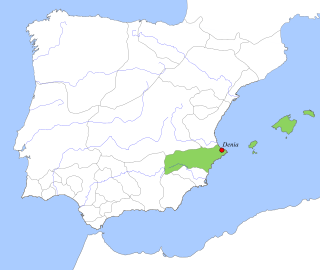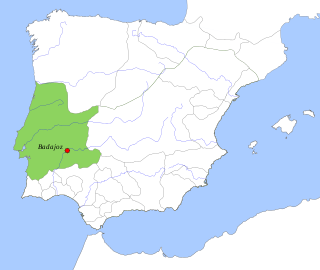
Rodrigo Díaz de Vivar was a Castilian knight and warlord in medieval Spain and came to be known by the Moors as El Cid, and by the Christians as El Campeador. He was born in Vivar del Cid, a village near the city of Burgos. As the head of his loyal knights, he came to dominate the Levante of the Iberian Peninsula at the end of the 11th century. He reclaimed the city of Valencia from Moorish control for a brief period during the Reconquista, creating the independent Señorío de Valencia from 17 June 1094 until his death in 1099; his wife, Jimena Díaz, inherited the city and maintained it until 1102 when it was reconquered by the Moors.

The County of Urgell is one of the historical Catalan counties, bordering on the counties of Pallars and Cerdanya.

The taifas were the independent Muslim principalities of the Iberian Peninsula, referred to by Muslims as al-Andalus, that emerged from the decline and fall of the Umayyad Caliphate of Córdoba between 1009 and 1031. They were a recurring feature of al-Andalus history. Conquered by the Almoravids in the late 11th century, on its collapse many taifas re-appeared only to be subsumed by the Almohads. The fall of the latter resulted in a final flourishing of the taifas, but by the end of the 13th century only one remained, Granada, the rest being incorporated into the Christian states of the north.

The Banu Hud were an Arab dynasty that ruled the taifa of Zaragoza from 1039 until 1110 and then most of al-Andalus from 1228 until 1237.
Abū Bakr Muḥammad ibn ʿAmmār, known as Ibn Ammar, in Spanish sources found as Abenámar, was a Muwallad poet from Silves.
Phi Centauri, Latinized from φ Centauri, is a blue-white hued star in the southern constellation Centaurus. It is visible to the naked eye with an apparent visual magnitude of +3.7. The annual parallax shift is 6.21 mas as measured from Earth, which yields a distance estimate of around 530 light years. It is moving further from the Sun with a radial velocity of +5 km/s.
J Centauri is a star in the constellation Centaurus. It is approximately 350 light years from Earth.
The Battle of Sagrajas, also called Zalaca or Zallaqa, was a battle between the Almoravid army led by their King Yusuf ibn Tashfin and an army led by the Castilian King Alfonso VI. The battleground was later called az-Zallaqah because of the poor footing caused by the tremendous amount of blood shed that day, which gave rise to its name in Arabic.

The taifa of Toledo was a Berber Muslim taifa located in what is now central Spain. It existed from the fracturing of the long-eminent Muslim Caliphate of Córdoba in 1035 until the Christian conquest in 1085.

The Taifa of Valencia was a medieval Moorish taifa kingdom which existed, in and around Valencia, Spain during four distinct periods: from 1010 to 1065, from 1075 to 1099, from 1145 to 1147 and last from 1229 to 1238 when it was finally conquered by the Aragon.

Yahya ibn Ismail al-Mamun was the second ruler of the Berber Hawwara Dhulnunid dynasty who was king of the Taifa of Toledo between 1043 and 1075.

The taifa of Dénia was an Islamic Moorish kingdom in medieval Spain, ruling over part of the Valencian coast and Ibiza. With Dénia as its capital, the taifa included the Balearic Islands and parts of the Spanish mainland.

The Taifa of Badajoz was a medieval Islamic Moorish kingdom located in what is now parts of Portugal and Spain. It was centred on the city of Badajoz which exists today as the first city of Extremadura, in Spain.

Aledo is a municipality in the Region of Murcia, southern Spain.
The siege of Tudela was the main action of the French military campaign in Spain in 1087 in conjunction with Kings Alfonso VI of León and Castile and Sancho V of Navarre and Aragon. The arrival of a French army under Odo I, Duke of Burgundy, and William, Viscount of Melun, early in the spring of 1087 was a response to Alfonso's plea for military aid, which was generated by the offensive of the Almoravids on Iberia. After defeating Alfonso at the Battle of Sagrajas on 23 October 1086, the Almoravids retreated before the French could arrive. Alfonso then convinced his allies to direct their energies at Tudela, the northernmost fortress of the taifa of Zaragoza. The siege was a complete failure militarily, but several important negotiations took place there among the besieging parties.
Umm al-Kirām bint al-Mut'asim b. Sumādih was a princess and Andalusian poet, daughter of Abu Yahyà Muhammad ben Ma'n, al-Mutasim, king of the Taifa of Almería.
The Dhulnunid dynasty or Dhunnunid dynasty was a Berber dynasty that reigned over the Taifa of Toledo in Spain in the 11th century.
Yahya ibn Ismaíl ibn Yahya al-Qadir bi-L-lah or al-Qadir, was the Dhulnunid ruler of the Taifa of Toledo in Spain between 1075 and 1085 and of the Taifa of Valencia from 1086 until his death.
Abu Ahmad Jaafar bin Abdullah bin Jahaf al-Ma’afari or Ibn Yahhaf was a judge and was the last ruler of the Taifa of Valencia before it fell to El Cid in 1094.
This page is based on this
Wikipedia article Text is available under the
CC BY-SA 4.0 license; additional terms may apply.
Images, videos and audio are available under their respective licenses.









